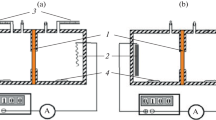Summary
Anomalous osmotic water flows may be the basis of the hypotonicity of gastric juice sampled at low rates of secretion. The anomalous osmotic flows of water produced by the exchange of hydrogen and a series of cations across the three membranes used in the electroosmotic studies (Paper I) have been obtained. The solvent flow results in part from the momentum imparted by the moving ions to the water contained in the membrane matrix. The physical parameters that regulate the rate of bi-ionic exchange and the accompanying anomalous osmotic solvent flows are: the hydration states of the membranes; the molarities of the membranes and the mobilities of the exchanging ions which are a function of ion size. Each ion in the exchange produces a flow of liquid. Assuming that the ions do not interact with one another in the membrane, the anomalous osmotic flux was assumed to be the sum of the water flows produced by each permeant ion. The anomalous osmotic flux produced by a bi-ionic exchange was calculated from electroosmotic coefficients ([EO]cation and [EO]Cl) and the ion-exchange rates. The calculated values were all 10 to 60% less than the observed values. Part of these differences may have resulted from concentration gradients in unstirred boundary layers adjacent to the membrane which caused an osmotic flow of water in the direction of net water movement. As in the stomach, the sodium-hydrogen exchange produced a hypotonic solution.
Similar content being viewed by others
References
Bagner, C. 1966. Studies in electroosmosis through ion-exchange membranes. M.S. Thesis. Polytechnic Institute of Brooklyn, Brooklyn, New York.
Berkowitz, J. M., Janowitz, H. D. 1966. Alteration in composition of hydrochloric acid solutions by gastric mucosa. Amer. J. Physiol.210:216.
Chapman, M., Werther, J. L., Janowitz, H. D. 1968. Response of the normal and pathological human gastric mucosa to an instilled acid load.Gastroenterology 55:344.
Davenport, H. W. 1964. Gastric mucosal injury by fatty and acetylsalicylic acids.Gastroenterology 46:245.
Dyck, W. P., Werther, J. L., Rudick, J., Janowitz, H. D. 1969. Electrolyte movement across canine antral and fundic gastric mucosa.Gastroenterology 56:488.
Grim, E., Sollner, K. 1957. The contribution of normal and anomalous osmosis to the osmotic effects arising across charged membrane with solutions of electrolytes.J. Gen. Physiol. 40:887.
Grim, E., Sollner, K. 1960. True anomalous osmosis in multisolute model membrane systems.J. Gen. Physiol. 44:381.
Hollander, F. 1936. Components of gastric secretion.Amer. J. Digest. Dis. Nutrition 3:651.
Hollander, F. 1943. Chemistry and mechanics of hydrochloric acid formation in stomach.Gastroenterology 1:401.
Lakshminarayanaiah, N. 1969. Transport Phenomena in Membranes. Academic Press Inc., New York.
Lifson, N., Varco, R. R., Visscher, M. B. 1943. Relationship between total osmotic pressure of gastric juice and its acidity.Gastroenterology 1:784.
Linde, S., Teorell, T., Obrink, K. J. 1947. Experiments on primary acidity of gastric juice.Acta Physiol. Scand. 14:220.
Lindner, A. E., Cohen, N., Dreiling, D. A., Janowitz, H. D. 1963. Electrolyte changes in the human stomach following instillation of acid solutions.Clin. Sci. 25:195.
Maklouf, G. M., McManus, J. P. A., Card, W. I. 1966. A quantitative statement of the two-component hypothesis of gastric secretion.Gastroenterology 51:149.
Nightingale, E. R., Jr. 1959. Phenomenological theory of ion solvation. Effective radii of hydrated ions.J. Phys. Chem. 63:1381.
Praissman, M., Miller, I. F., Berkowitz, J. M. 1973. Ion-mediated water flow. I. Electroosmosis.J. Membrane Biol. 11:139.
Rehm, W. S., Butler, C. F., Spangler, S. G., Sanders, S. S. 1970. A model to explain uphill water transport in the mammalian stomach.J. Theoret. Biol. 27:433.
Robinson, R. A., Stokes, R. H. 1959. Electrolyte Solutions, 2nd Edition. Butterworths, London, England.
Tasaka, M., Kondo, Y., Nagasawa, M. 1969. Anomalous osmosis through charged membranes.J. Phys. Chem. 72:3181.
Teorell, T. 1939. On the permeability of the stomach mucosa for acids and some other substances.J. Gen. Physiol. 23:263.
Teorell, T. 1947. Electrolyte diffusion in relation to acidity regulation of gastric juice.Gastroenterology 9:425.
Tombalakian, A. S., Worsley, M., Graydon, W. F. 1966. Solvent mass transfer across ion-exchange membranes.J. Amer. Chem. Soc. 88:661.
Author information
Authors and Affiliations
Additional information
Presented in part before the national meeting of the American Gastroenterological Association, Philadelphia, Pa., May, 1968, and before the American Physiological Society at the 54th meeting of the F.A.S.E.B., Atlantic City, N. J., April, 1970.
Rights and permissions
About this article
Cite this article
Praissman, M., Miller, I.F., Gregor, H.P. et al. Ion-mediated water flow. J. Membrain Biol. 11, 153–167 (1973). https://doi.org/10.1007/BF01869818
Received:
Issue Date:
DOI: https://doi.org/10.1007/BF01869818



